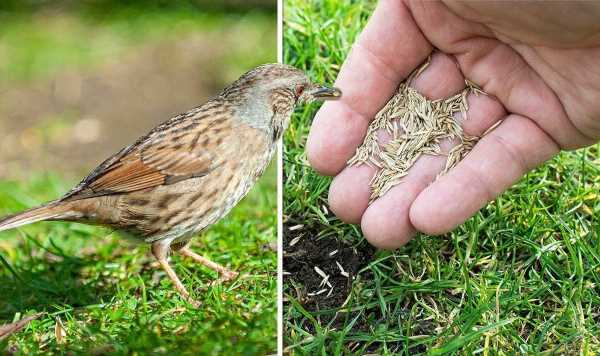Lawn seed will struggle to germinate if disturbed in the first eight to 12 weeks after sowing and should be left alone to allow the seedlings to grow. While foot traffic and pets are easier to keep off a fresh layer of seed, garden birds can be trickier to keep off of your garden grass. Scare tactics and planting techniques are the most effective ways to protect a new lawn from being eaten in the early stages – and these are the best methods to try at home.
How to stop birds eating grass seed
Stopping birds from visiting your garden is impossible to do, but there are ways to prevent them from diving into freshly sown grass seed.
Rake your seeds
The first step to protecting your lawn is increasing the depth at which the seeds are spread on the ground.
World Birds said: “Before you go with any kind of a cover, it is better for you to rake your seeds up to ⅛ of an inch under the soil.
“It will provide the seeds with a natural cover, and you won’t have to do much to deter the birds from eating seeds.”

We use your sign-up to provide content in ways you’ve consented to and to improve our understanding of you. This may include adverts from us and 3rd parties based on our understanding. You can unsubscribe at any time. More info

Cover your lawn
Creating a physical barrier to protect your lawn is the quickest and easiest way to stop birds from ruining your hard work.
In the first few days after sowing new seeds, you can cover them with a tarpaulin or net covering before they start to grow.
According to icanlawn.com, the seedlings will no longer be at risk of being “gobbled up” by hungry birds once germination begins.
Lift the covering regularly to check on the progress of your lawn.
Once you can see that the seeds are growing fresh green blades, it is safe to remove the tarpaulin.

Lay garden fleece
While garden fleece serves the same function as tarpaulin, it comes with the added benefit of speeding up the germination process.
According to Lawnsmith, horticultural fleece offers “very effective” protection from birds and also increases the soil temperature – allowing the grass underneath to “breathe and not cook”.
Simply cover the entire area with the fleece material and continue to water the seed to stimulate growth.
The covering can be removed once the seed has transformed into green seedlings.
DON’T MISS:
Lawn: Common causes of ‘patchy’ grass and how to revive it [INSIGHT]
What to ‘never’ do with a paddling pool if you want to protect lawns [REVEAL]
Alan Titchmarsh shares how to get hydrangeas to ‘really shine’ [ANALYSIS]

Use fake predators
Hungry birds will be reluctant to land in your garden if you have a fake predator present.
World Birds said: “Birds don’t want to be in the area where they have spotted their predators lurking around.
“They don’t care how tasty the birdseed seems. A fake owl, hawk, or even a rubber snake will work pretty fine.”
For this method to be effective, you will need to change the position of the predators regularly, or else the birds may become wise to your plan.
A rotating head feature will add to the “realism” the predator statue has to offer, and will keep birds from pecking at the fresh lawn.
Use a ‘decoy’ feeder
The art of distraction could work in your favour if you have a larger garden.
A bird looking for seed to eat will opt for an ‘easy feed’ area over a treacherous attempt to dive into your lawn for food.
Therefore, you can lure birds away from your lawn and into a designated feeding area where they easily access food.
Position a bird feeder as far away from your lawn as possible and keep it topped up.
The birds should pay no attention to your grass seeds and will instead focus on tucking into the feeder.
Source: Read Full Article
